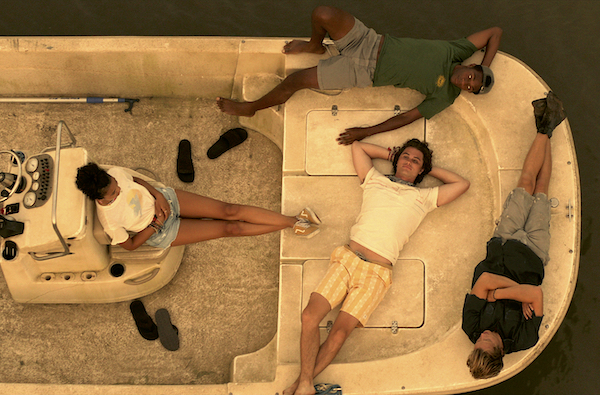Shannon Burke is the author several novels including Safelight, Black Flies, and Into the Savage Country. Recently, he decided to partner with his screenwriting friends, brothers Jonas and Josh Pate to work on a coming-of-age, action-adventure story for Netflix.
“I kept writing my novels, but simultaneously, I would work on this parallel screenwriting career,” said Burke. “I would work on films and for twenty years, I would write fiction and then write movies. I never planned on having a TV or movie career, but it happened.”
Josh Pate also wanted to be a novelist, majoring in English at the University of North Carolina. His twin brother, Jonas, was highly invested in film, so Josh eventually moved in that direction as well.
“I worked on a novel when I got out of school and quickly realized it was way too hard,” joked Pate. “So we tried writing a screenplay.” The Brothers Pate moved from New York back to the East Coast of North Carolina.
While living on Wrightsville Beach, they found inspiration for what would become Outer Banks, but also took a gamble to get their first script noticed.
“We were living on the beach and had a screenplay. Dennis Hopper had a house there. We got a bed sheet and hung it on the light post across from Dennis Hopper’s house.” The bedsheet read, “Dennis, We have a script. Call us.”

Josh Pate
About two months later, they actually received a phone call from Dennis Hopper, who invited them over to watch basketball and discuss their screenplay.
Cutting the Safety Net To Pursue A Screenwriting Career
“I wouldn’t describe the transition to screenwriting as confident,” said Pate. “I really wanted to make books or movies. It was more like desperation than confidence, but I also took it really seriously and I tried for a long time to become a better writer.”
Around the time Pate reached out to Hopper, he had been writing seriously for five years. “I had written a lot and my thesis was a book of short stories. When I got out of school, I wrote a three-hundred page novel and burned it, because I read it and realized how badly it sucked.”
Pate wanted someone to read his work because he felt more comfortable with it. Burke added, “I also had no confidence. I don’t know if I have confidence now, but if it’s the only thing you do, it doesn’t matter if you have confidence or not. It’s a level of resignation.”
Burke actually related the career leap to the idea of “destroying your life.” He originally went to school to be a lawyer, so taking the path of a fiction writer meant cutting the safety net, but also deciding to be a writer, despite what that meant for his previously desired career.
“I was just going to write and I ended up becoming a paramedic. But at that time in the mid-90s, everybody you knew was getting rich. There was a huge upswing and everybody was getting rich, and I was living in the worst circumstances, living in New York City as an EMS.”
Despite the actual circumstances, Burke was able to find seven to eight hours a day to write. “By the time you have something, it’s not confidence, but you’ve destroyed your life, or changed your life to do this thing. You have no choice, so you might as well give them something.”
Novels and Screenplays
“In the big picture, if you put enough work in, you don’t have any choice but to show people what you’ve done because you’ve spent thousands and thousands of hours doing it. You slowly understand how to do it and you have no choice but to try.”
Looking back at his career, Burke sees himself as a screenwriter and an author, rather than more one over the other. “If I was practical, I would never write another word of fiction,” he joked. “In every way, more people see movies and TV, and you get paid a lot more for it, so [writing novels] is an insanely time-consuming hobby, but I like it. You get way more freedom and you can be personal, without having to worry that you’re being personal.”
Moving from the novel to the screenwriting mindset feels the same for the duo. “The thinking is the same. Literally ninety percent of writing is thinking, and getting the right pattern, the scene, the characters, and all that stuff is the same.”

Shannon Burke
Burke compares his novels to the same plot length as a season of television. “It’s super familiar. There’s a big overlap, so only the very end piece is one way or another. But my novels are personal. My new book is about my childhood,” he added. “I don’t think you can do that on TV in the same way. TV needs a broader appeal.”
Writing Outer Banks
The idea of Outer Banks came from an article about a power outage on the Outer Banks. Pate said, “There was a photograph taken at dusk of these darkened mansions. It was just this evocative image that stayed with me.”
Pate mentioned his fascination with this idea to Burke, and they started to unveil the story that would later become the Netflix series. “We wanted to do something based on memories from high school and that period of adolescence.”
According to the description, the series is about, “A group of teenagers from the wrong side of the tracks stumble upon a treasure map that unearths a long-buried secret.”
Rather than looking to other NC-centric shows like Dawson’s Creek and One Tree Hill, the team looked to favorite books on adolescence, like The Outsiders. Using these high school memories, they could start to craft a new story.
“There was a beach scene that was very have- and have-not,” said Pate. “A lot of those scenes are biographical and then Shannon [Burke] brought his own high school memories into it, so it started to evolve.”
“We had this bed of characters that evolved and a place that was a real sense of place,” said Pate. When they told Josh’s brother Jonas about the plot, he mentioned that they needed to add some “juice,” meaning an element of genre.
They chose action and adventure.
Modern Swashbuckling
“We really admired Treasure Island and those Victorian, fast-paced adventure novels. Sometimes we’ll talk about books from the 1800s and they’re kind of forgotten things. Treasure Island was such a good story,” said Pate.
Using this motivation, they started to think more about adding the elements of a treasure hunt, but also some elements from books like Anna Karenina (specifically relating their character John B’s plot to the action sequences with Vronsky).
“A lot of the touchstones came from 19th Century authors,” said Burke. By constantly talking about their favorite books, the writers created a shorthand of reference points to create tentpole plot moments within the story.

The cast of Outer Banks (Photo: Courtesy Of Netflix)
The same is true for classic adventure films, like the Indiana Jones movies. After watching Raiders over and over again, the writers could start to reverse engineer the moments that inspired them to create inspiring moments. “They’re tricks of the trade, but they start to become obvious when you study them.”
“We get inspiration from these classic moments, then you try to do your own thing,” said Pate. “They’re archetypical scenes and we talk a lot about classic scenes, why they resonate, and it’s just theoretical shop talk, but the actual process is very different.”
Logistically, Shannon Burke and Josh Pate write everything, where Jonas Pate is there to direct (but he’s also in the metaphorical TV writers’ room for the entire process). “It goes through the meat grinder of the two of us writing pages. We have a loose plan, send them back and forth, and it slowly starts to emerge.”
The writers made note that it’s quite different from most TV writing rooms. “It’s an odd process we have, that’s a product of our friendship.”
The Writing Formula
As for moments that feel off or stuck, the writers focus on what the character is thinking in that moment. “It’s not magic, it’s logic. The character doesn’t need to act how you move him across a chessboard, but how that character would act in that situation.”
“Sometimes we get caught up in a caper, but when we go back to the knitting of what’s happening, we ask, ‘How would the characters feel?’ Once we understand that better, it breaks the ice and it makes the story better.”
Across the board, the writing team is focused on creating “dramatic tension” within “universal themes.” Burke said, “What’s the universal touchstone and how to do that in the most dramatic way? Those are the two masters that are pulling us.”
Despite the positive intentions, it’s a lofty goal that causes as much failure as success. Pate clarified, “With every script we finish, there’s a fifty-page script where we’ve written three hundred pages. We try things and if it’s failing to create tension or isn’t a powerful enough plot… we can’t think our way to the solution. We have to write our way to the solution. We throw a lot away.”
Burke concluded, “I think both of us are good at sensing when something works. Once you have eight, nine, or ten pages that work, we smell blood in the water and you can feel what comes next. You go forward, push the rock forward, and eventually, you get the whole script. It’s not planned. It’s instinct.”
“It’s hard to get traction, but once you get started, you know what’s next,” he said. “You sort of know what those universal things are and ask yourself, ‘What do I want to see next?’ You need room to have inspiration.”
This interview has been condensed. Listen to the full audio version here.

